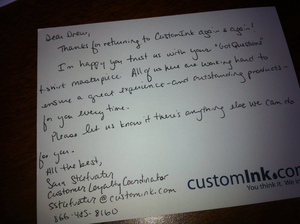How CustomInk.com creates a love affair with me
July 19, 2011

...they even send love notes!
There’s no valuable and ROI focused marketing goal greater or more effective than to create a love affair with your customer. Remember the perks:
- It feels good
- It’s easier to sell more to a current customer than something to a new one
- It’s more profitable
- It generates word of mouth
- It’s incredible for employee retention
And here’s a little case study to prove my point.
We’re an agency, I sit on the boards of several not-for-profits and I was very active in my daughter’s high school. All of that adds up to a ton of t-shirt purchases throughout the year. A few years ago, we stumbled upon CustomInk. I was shopping for cheap, t-shirts for a fundraising event for one of the boards I’m on and couldn’t find the right quality for the right price locally.
The experience I had with CustomInk that first go around made me a customer for life. And every interaction I have with them since that first one just reinforces my buying decision.
Here’s how they create a love affair with their customers.
They are accessible: Live chat on their website, a phone number to a real person, very fast e-mail support — I’m pretty sure I could even send them a carrier pigeon and they’d get back to me.
They give me the tools to be successful: Whether you’re a novice and need clip art and suggestions to a pro who wants to upload print ready files — they have easy to use tools to let you do business with them the way you want to do business.
Their store (website) is well organized, has lots of help prompts and let’s me get to it: God love them for organizing their site in a way that lets me search by price or by color or by quality. I never have to wonder “where would I go to do XYZ” because I always know.
When things go wrong (on our end)– they bend over backwards: If they think your shirts (or whatever you print) aren’t going to turn out well due to a design issue or if they just think your logo needs to be cleaned up — they do it. They’re helpful and they don’t make you feel like a dope.
They support what I support: Every time I do t-shirts for a fundraising type event — they call the organization and make a donation. It’s not a huge dollar amount ($20 or so) but the gesture means a great deal.
I get a person: Once my t-hsirts are in production, the work is assigned a staff person who oversees the order until it is shipped. When I e-mail or call – I am connecting directly to that person. When I have an art question — I’m assigned an art person who helps me get it right. Follow up question — go back to your person.
They’re grateful: They go out of their way to let me know they appreciate my business. I’m sure I am a small fish in their pond but they always check to make sure we were happy once the t-shirts get delivered and as you can see, every once in awhile, I get a hand written note.
None of what they do is rocket science but all of what they do is a sincere effort to connect with, support and thank their customers. They’re an online company that understand the importance and power of creating real relationships.
I feel the love…and love them in return!
How about you — is there a brand that’s created a love affair with you? How’d they do it?
More











